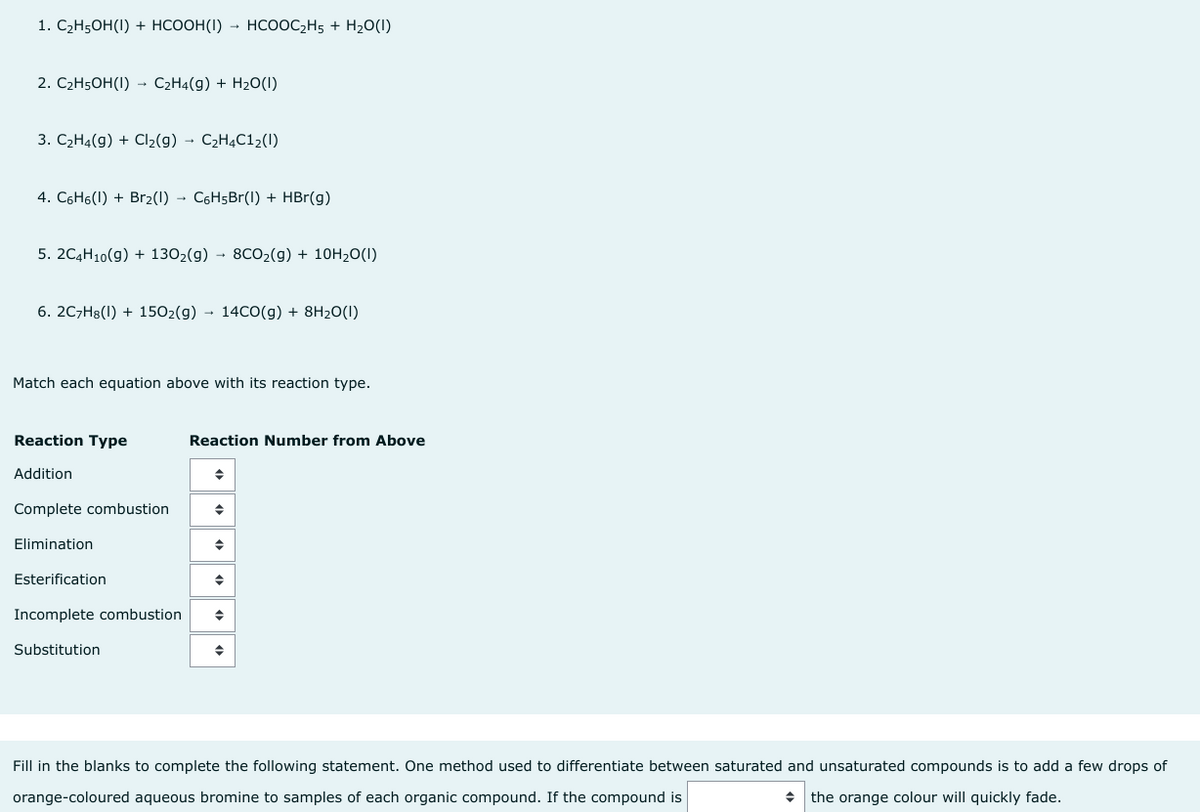1. CzH5OH(I) + HCOOH(I) → HCOOCzHs + H2O(I) 2. C₂H5OH(1)→ C₂H4(9) + H₂O(1) 3. C₂H4(9) + Cl₂(g) → C₂H4C12(1) 4. C6H6(1) + Br₂(1) C6H5Br(1) + HBr(g) 5. 2C4H10(9) + 130₂(g) → 8CO₂(g) + 10H₂O(l) 6. 2C7H8(1) + 150₂(g) 14CO(g) + 8H₂O(1) Match each equation above with its reaction type. Reaction Type Addition Complete combustion Elimination Esterification Incomplete combustion Substitution Reaction Number from Above 4 ( → ( O O
1. CzH5OH(I) + HCOOH(I) → HCOOCzHs + H2O(I) 2. C₂H5OH(1)→ C₂H4(9) + H₂O(1) 3. C₂H4(9) + Cl₂(g) → C₂H4C12(1) 4. C6H6(1) + Br₂(1) C6H5Br(1) + HBr(g) 5. 2C4H10(9) + 130₂(g) → 8CO₂(g) + 10H₂O(l) 6. 2C7H8(1) + 150₂(g) 14CO(g) + 8H₂O(1) Match each equation above with its reaction type. Reaction Type Addition Complete combustion Elimination Esterification Incomplete combustion Substitution Reaction Number from Above 4 ( → ( O O
Chemistry: Principles and Reactions
8th Edition
ISBN:9781305079373
Author:William L. Masterton, Cecile N. Hurley
Publisher:William L. Masterton, Cecile N. Hurley
Chapter16: Spontaneity Of Reaction
Section: Chapter Questions
Problem 92QAP
Related questions
Question

Transcribed Image Text:1. CzH5OH(I) + HCOOH(I) → HCOOCzHs + H2O(I)
2. C₂H5OH(1)→ C₂H4(g) + H₂O(1)
3. C₂H4(9) + Cl₂(g) → C₂H4C12(1)
4. C6H6(1) + Br2(1)→ C6H5Br(1) + HBr(g)
5. 2C4H10(9) + 130₂(g) → 8CO₂(g) + 10H₂O(1)
6. 2C7H8(1) + 150₂(g) → 14CO(g) + 8H₂O(1)
Match each equation above with its reaction type.
Reaction Type
Addition
Complete combustion
Elimination
Esterification
Incomplete combustion
Substitution
Reaction Number from Above
→
◆
◆
Fill in the blanks to complete the following statement. One method used to differentiate between saturated and unsaturated compounds is to add a few drops of
orange-coloured aqueous bromine to samples of each organic compound. If the compound is
◆ the orange colour will quickly fade.
Expert Solution
This question has been solved!
Explore an expertly crafted, step-by-step solution for a thorough understanding of key concepts.
This is a popular solution!
Trending now
This is a popular solution!
Step by step
Solved in 3 steps

Knowledge Booster
Learn more about
Need a deep-dive on the concept behind this application? Look no further. Learn more about this topic, chemistry and related others by exploring similar questions and additional content below.Recommended textbooks for you

Chemistry: Principles and Reactions
Chemistry
ISBN:
9781305079373
Author:
William L. Masterton, Cecile N. Hurley
Publisher:
Cengage Learning

Chemistry: The Molecular Science
Chemistry
ISBN:
9781285199047
Author:
John W. Moore, Conrad L. Stanitski
Publisher:
Cengage Learning

Chemistry & Chemical Reactivity
Chemistry
ISBN:
9781337399074
Author:
John C. Kotz, Paul M. Treichel, John Townsend, David Treichel
Publisher:
Cengage Learning

Chemistry: Principles and Reactions
Chemistry
ISBN:
9781305079373
Author:
William L. Masterton, Cecile N. Hurley
Publisher:
Cengage Learning

Chemistry: The Molecular Science
Chemistry
ISBN:
9781285199047
Author:
John W. Moore, Conrad L. Stanitski
Publisher:
Cengage Learning

Chemistry & Chemical Reactivity
Chemistry
ISBN:
9781337399074
Author:
John C. Kotz, Paul M. Treichel, John Townsend, David Treichel
Publisher:
Cengage Learning

Chemistry & Chemical Reactivity
Chemistry
ISBN:
9781133949640
Author:
John C. Kotz, Paul M. Treichel, John Townsend, David Treichel
Publisher:
Cengage Learning

Introductory Chemistry: A Foundation
Chemistry
ISBN:
9781285199030
Author:
Steven S. Zumdahl, Donald J. DeCoste
Publisher:
Cengage Learning
